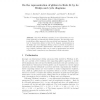Free Online Productivity Tools
i2Speak
i2Symbol
i2OCR
iTex2Img
iWeb2Print
iWeb2Shot
i2Type
iPdf2Split
iPdf2Merge
i2Bopomofo
i2Arabic
i2Style
i2Image
i2PDF
iLatex2Rtf
Sci2ools
122
click to vote
ACRI
2008
Springer
2008
Springer
On the Representation of Gliders in Rule 54 by De Bruijn and Cycle Diagrams
Abstract. Rule 54, in Wolfram’s notation, is one of elementary yet complexly behaving one-dimensional cellular automata. The automaton supports gliders, glider guns and other non-trivial long transients. We show how to characterize gliders in Rule 54 by diagram representations as de Bruijn and cycle diagrams; offering a way to present each glider in Rule 54 with particular characteristics. This allows a compact encoding of initial conditions which can be used in implementing non-trivial collision-based computing in one-dimensional cellular automata. 1 Preliminaries Amongst one-dimensional cellular automata (CA) studied by Wolfram in [15, 16], one can find a few evolution rules supporting gliders (particles or mobile self-localizations); rules 110 and 54 exhibit particularly rich and somewhat complex behaviour.3 Interaction between gliders can be employed to execute logical operations, and thus ultimately to perform universal computation [1]. Collisionbased computing schemes are ver...
| Added | 01 Jun 2010 |
| Updated | 01 Jun 2010 |
| Type | Conference |
| Year | 2008 |
| Where | ACRI |
| Authors | Genaro Juárez Martínez, Andrew Adamatzky, Harold V. McIntosh |
Comments (0)

